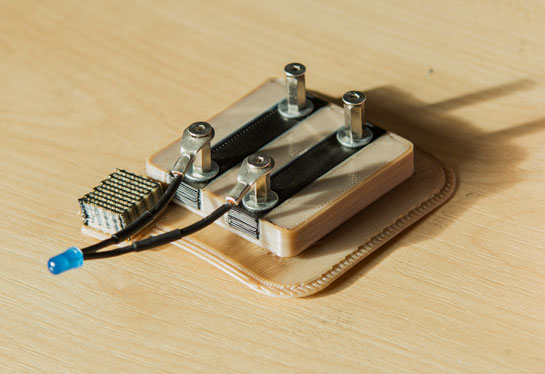Demonstrator Made on Zortrax 3D Printer Will Fly to Space
A demo model with embedded electrically conductive paths 3D printed on the Zortrax Endureal will fly to space onboard the WISA Woodsat mission.

WISA Woodsat may make the first satellite made out of birchwood. Image courtesy of Zortrax.
November 9, 2021
3D printed electrical circuit made on Zortrax Endureal will be tested onboard the WISA Woodsat CubeSat scheduled for launch in the first half of 2022. Zortrax has worked with the support of the European Space Agency to develop a composite 3D printing technology that enables fabricating space-ready parts with built-in polymeric-based electrical circuits since late 2019. An ESA-designed functional demonstrator made with this technology will be flight-tested in low earth orbit in this pioneering mission.
The first stage of this project was concluded using the Endureal to make Z-PEEK structures with embedded, electrically conductive paths printed with electrically conductive PEEK supplied by ESA. Zortrax engineers used dual extrusion with two blends of PEEK to print advanced parts with power and data transfer capabilities.
Making Composite Prints Space-Ready

Once Zortrax could print simultaneously with two blends of PEEK, the R&D team at Zortrax started perfecting the technology, according to Zortrax. For models printed with this technique to be ready for spaceflight, several issues had to be solved. Improvements were made in three key areas:
- Dimensional accuracy had to be improved to enable printing smaller parts that would fit on CubeSats.
- Conductivity of the paths made with conductive paths had to be increased to make power and data transferring less energy intensive.
- Gaps in the printed models had to be eliminated to get rid of air trapped in the models that could expand under vacuum.
Improving Dimensional Accuracy with PEEK
First, composite prints were relatively large. In the first proof-of-concept models there were imperfections, Zortrax notes.
These imperfections were there partially because at the beginning Zortrax engineers used printing temperatures exceeding 430°C, which was very high even for PEEK. The reason behind this was to achieve uniform distribution of graphene nano-particles and carbon nanotubes present in the conductive PEEK to increase conductivity of the conductive paths. This goal was achieved at a cost of dimensional accuracy, according to Zortrax.
By improving PEEK printing profiles and algorithms working in Z-SUITE software, Zortrax team brought the printing temperatures back to standard 400°C for standard and conductive PEEK blends with no adverse effect on conductivity. Details became more pronounced, edges sharper and surfaces smoother as the PEEK material extruded in lower temperature could be precisely deposited in the right spots by the printing head.
Increasing Electrical Conductivity in ESA’s PEEK
At the early stages, Zortrax engineers exceeded conductivity values initially achieved by ESA with conductive PEEK filament. ESA, while developing this material, used now discontinued INDMATEC HPP 155 3D printer for test prints. This machine could not reach the printing temperatures possible to achieve on the Endureal. It also lacked a heated printing chamber.
The initial improvement in conductivity was possible because the Endureal offered more advanced options for thermal management. But Zortrax looked to increase the conductivity even further. This was achieved through modifying software.
Initial tests performed with models 3D printed with ESA’s conductive PEEK showed that the conductivity in the material was anisotropic. It was relatively high, provided the current flew along the paths followed by a printing head when the model was printed. It was low, however, when the electrons were forced to flow against those paths. In a typical 3D printed part made with 100% infill with 45-degrees raster angle, the current flew against the paths in almost all scenarios.
To solve this, Zortrax team employed an experimental Z-SUITE feature that radically change the pathing followed by a printing head in the Endureal. Working in this mode, the printer begins printing the object from its outer rim and then proceeds to deposit ever smaller rims moving inward. This technique is used to improve mechanical properties of 3D prints but it also caused an increase of conductivity values in conductive PEEK models.
Advanced Materials for Space Industry
WISA Woodsat is a mission focused on testing new materials and manufacturing technologies in space industry. Several parts of this CubeSat are made of birch wood covered with a coating designed to protect it from space environment effect. It will be launched onboard a partially recoverable Electron rocket, which has large parts of its body fabricated with lightweight carbon composites.
WISA Woodsat with Zortrax 3D printed demonstrator onboard is scheduled for launch in the first half of 2022 from New Zealand. Apart from printing the PEEK demonstrator with embedded electrically conductive paths, Zortrax is currently working with ESA on two new research projects.
The WISA Woodsat has been initiated and is led by Arctic Astronautics, a Finnish company specializing in CubeSat components and developing space technologies for education. Birch wood for the satellite’s frame has been supplied by UPM Plywood, a global manufacturer of plywood and veneer products. A deployable “selfie stick,” another 3D printed instrument that will fly on WISA Woodsat mission, has been 3D printed by Delva, a Finnish metal 3D printing company.
Subscribe to our FREE magazine, FREE email newsletters or both!
About the Author
DE’s editors contribute news and new product announcements to Digital Engineering.
Press releases may be sent to them via [email protected].






